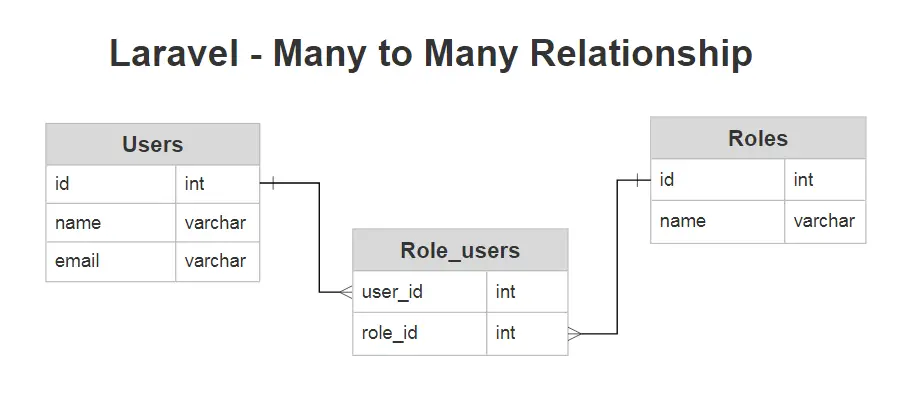Many To Many Relationship Laravel 9 Example
In this article, we will see many to many relationship in laravel 9 example. Many to many relationships are more complicated than one to one and one to many relationships. An example of like a relationship is a user with multiple roles, where the role are also connected with multiple users. Also, you can use many to many relationships in laravel 6 and laravel 7 and laravel 8.
So, let's see laravel 9 many to many relationship, laravel 9 hasMany example, laravel 9 eloquent relationships, and laravel 9 relationship.
We will create a User and Roles and Role_users table. all tables are connected to each other table. Now we will create many to many relationships with each other by using the laravel Eloquent Model.
Also, we will create migration with a foreign key, sync with a pivot table, retrieve records using the model, insert new records, update records, etc.

Now, we have to create migration for users and roles and role_users table. we will also add foreign keys to the users and roles table.
Create Migration of Users Table
Schema::create('users', function (Blueprint $table) {
$table->increments('id');
$table->string('name');
$table->string('email')->unique();
$table->timestamps();
});
Create Migration of Roles Table
Schema::create('roles', function (Blueprint $table) {
$table->increments('id');
$table->string('name');
$table->timestamps();
});
Create Migration of Role Users Table
Schema::create('role_users', function (Blueprint $table) {
$table->integer('user_id')->unsigned();
$table->integer('role_id')->unsigned();
$table->foreign('user_id')->references('id')->on('users')->onDelete('cascade');
$table->foreign('role_id')->references('id')->on('roles')->onDelete('cascade');
});
Now, we will create a User, Role model. we will use the belongsToMany() relationship for both models.
User Model:
<?php
namespace App\Models;
use Illuminate\Database\Eloquent\Model;
class User extends Model
{
/**
* Get the phone associated with the user.
*/
public function roles()
{
return $this->belongsToMany(Role::class, 'role_users');
}
}
Role Model:
<?php
namespace App\Models;
use Illuminate\Database\Eloquent\Model;
class Role extends Model
{
public function user()
{
return $this->belongsToMany(User::class, 'role_users');
}
}
Once the relationship is defined, we may retrieve the related record using Eloquent's dynamic properties.
$role = User::find(1)->roles;
$user = Role::find(1)->users;
In this step, we will create records in the role tables.
$user = User::find(1);
$role_ids = [1, 2];
$user->roles()->attach($role_ids);
$user = User::find(2);
$role_ids = [1, 2];
$user->roles()->sync($role_ids);
You might also like:
- Read Also: Laravel 9 Send Bulk Mail Using Queue
- Read Also: Dynamic Pie Chart Example In Laravel 9
- Read Also: Laravel whereDate and whereDay Example
- Read Also: How To Get Current Week Records In MySQL Query








